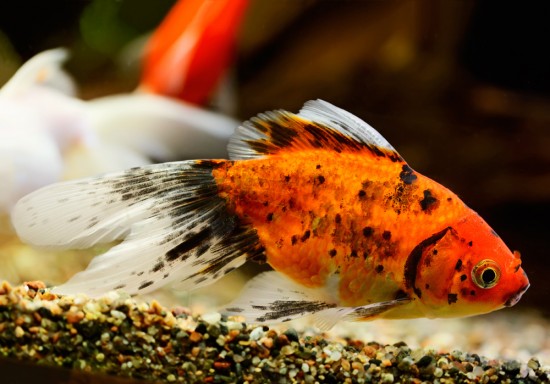

Bacterial ulcers are a very common problem in fish and seem to strike ornamental and pond fish such as goldfish and koi more often than other types. If lots of fish are affected they can prove difficult to treat as it can demand a high degree of patience, skill and expertise. However the good news is that the success rate when treating bacterial ulcers is often very high, even with severe or very advanced cases, unlike other infections such as bacterial gill disease.
We’re used to dealing with ulcers in our own mouths, but ulcers can occur on the skin too and if they appear on the skin of animals that live in water, they can be hard to manage. An ulcer is a wound on the skin that penetrates all the way through the layers to the muscle beneath.
Typically the ulcer will fail to heal and will feature an area of inflammation surrounding a central area of erosion. An area of white, necrotic tissue will normally surround the central wound and the inflamed area will usually extend into the healthy tissue, and the scales surrounding the affected area may become swollen and infected. In most cases the ulcer will not heal on its own and is typically caused by bacteria present in the tank or pond.
Ulcers are usually caused by damage to the skin inflicted by either parasites or exposure to high levels of chemicals such as ammonia or extreme ph. levels. Trauma caused by breeding or handling can also create damage to delicate skin structures that can then become infected, leading to ulceration.
Stressed fish, such as those who have recently been introduced to a tank or pond and whose immune system may be compromised may also be susceptible. Animals living in environments containing high levels of organic materials can also be prone to ulceration. If just one fish become ulcerated then it’s likely to be a problem with that particular animal. However, if more than one fish develops ulcers, then the cause is likely to be environmental.
If the pond or tank is thought to be the cause, it is worth investigating the root cause of the problem and eradicate any bacteria or parasites. Simply adding anti-bacterial treatments to the water will only work for so long if the cause is not addressed.
It’s important to remember that parasites will not ‘grow’ in a tank. They can only be introduced. Bacteria and viruses can exist in a tank as they can live quite happily on the fish that live there. If the equilibrium of the tank remains the same, the fish will remain healthy, however if the environment is disturbed either by a change in the maintenance routine or the introduction of new fish, then these pathogens can develop and grow, causing disease.
If only one fish is affected, and providing the infection is caught early enough, topical treatment may be enough. If more than one animal is ulcerated then all fish must be examined thoroughly to properly determine the spread of the infection. Many experts believe that debriding any wounds and applying a good quality topical treatment will be sufficient, but if you are inexperienced treatment should be carried out in conjunction with a vet.
Often when a fish develops an obvious ulcer the infection has already been present for some time. This could mean that many more fish are affected than just one with an obvious injury. It’s vital that all affected fish are treated simultaneously. Any untreated animals will continue to harbour bacteria and will continue to deteriorate. Many cases of bacterial infection can continue for months if only the most obviously affected animals are treated. It may seem like fresh outbreaks, but in actual fact you may be dealing with a chronic problem.
Treatment can consist of many things and your vet or local aquatic expert may suggest a programme of treatment made up of many elements. Any course of treatment of course depends on the severity of the infection, and if you’re not sure, you must consult a veterinarian or a fish expert.
Treatment options include topical medication that can be applied directly to the affected area of individual fish. Bathing treatments can also be used over the short or long-term and in extreme cases antibiotic injections can be administered. Whichever course of treatment is chosen, the aim should be for the problem to be resolved in two or three weeks. If the problems persist then a different treatment plan should be considered and an investigation into the cause of the infection should be carried out again.
Dirty pond or tank water can certainly cause bacterial infections, particularly if one or more fish have existing injuries. Attention should be paid to water quality and the filtration system to ensure this is working efficiently. Overcrowding can also contribute to disease as it can stress the animals and may even cause fights, and regular maintenance of the tank should also be thorough.
Cases of ulceration should be addressed in a systematic way as they can persist if treatment is not exhaustive. Trying different treatments in succession is unlikely to be effective and may even make the problem worse. A 90% survival rate should be the aim and anything less than this is likely to be down to ineffective treatment, rather than the infection itself.
 Do Sugar Gliders Make Good Pets?
Do Sugar Gliders
Do Sugar Gliders Make Good Pets?
Do Sugar Gliders
 How To Keep A Bearded Collies Coat Looking Good
How To Keep A Bea
How To Keep A Bearded Collies Coat Looking Good
How To Keep A Bea
 Training Your Dog Out Of Sleeping On Your Bed
Training Your Dog
Training Your Dog Out Of Sleeping On Your Bed
Training Your Dog
 Some Frequently Asked Questions About The Maine Coon Cat Breed
Some Frequently A
Some Frequently Asked Questions About The Maine Coon Cat Breed
Some Frequently A
 Recalled Foods Are Not Safe For Pet Consumption
Recalled Foods Are Not Safe For Pet Consumption
Recalled Foods Are Not Safe For Pet Consumption
Recalled Foods Are Not Safe For Pet Consumption
Copyright © 2005-2016 Pet Information All Rights Reserved
Contact us: www162date@outlook.com